Ketoanalogues are an increasingly fascinating part of the renal diet. They are a medical food created specifically for kidney patients. Our dietitians provide support for kidney patients that want to use ketoanalogues. There are several points to understand before ordering your own ketoanalogues. This article will cover everything you should know about ketoanalogues to protect your kidney health, including resources on how to get started.
Please speak with your physician prior to starting any new supplements. It is best practice to work with a renal dietitian when following the protocol below.
Table of Contents
What are ketoanalogues?
Ketoanalogues are breakdown forms of amino acids, aka protein building blocks.
However, they do not include a part of the amino acids that can be harder on kidneys. That part is nitrogen.
Nitrogen is harmful to kidney health as it can build up.
This can be seen in the renal function panel as part of the Blood Urea Nitrogen.
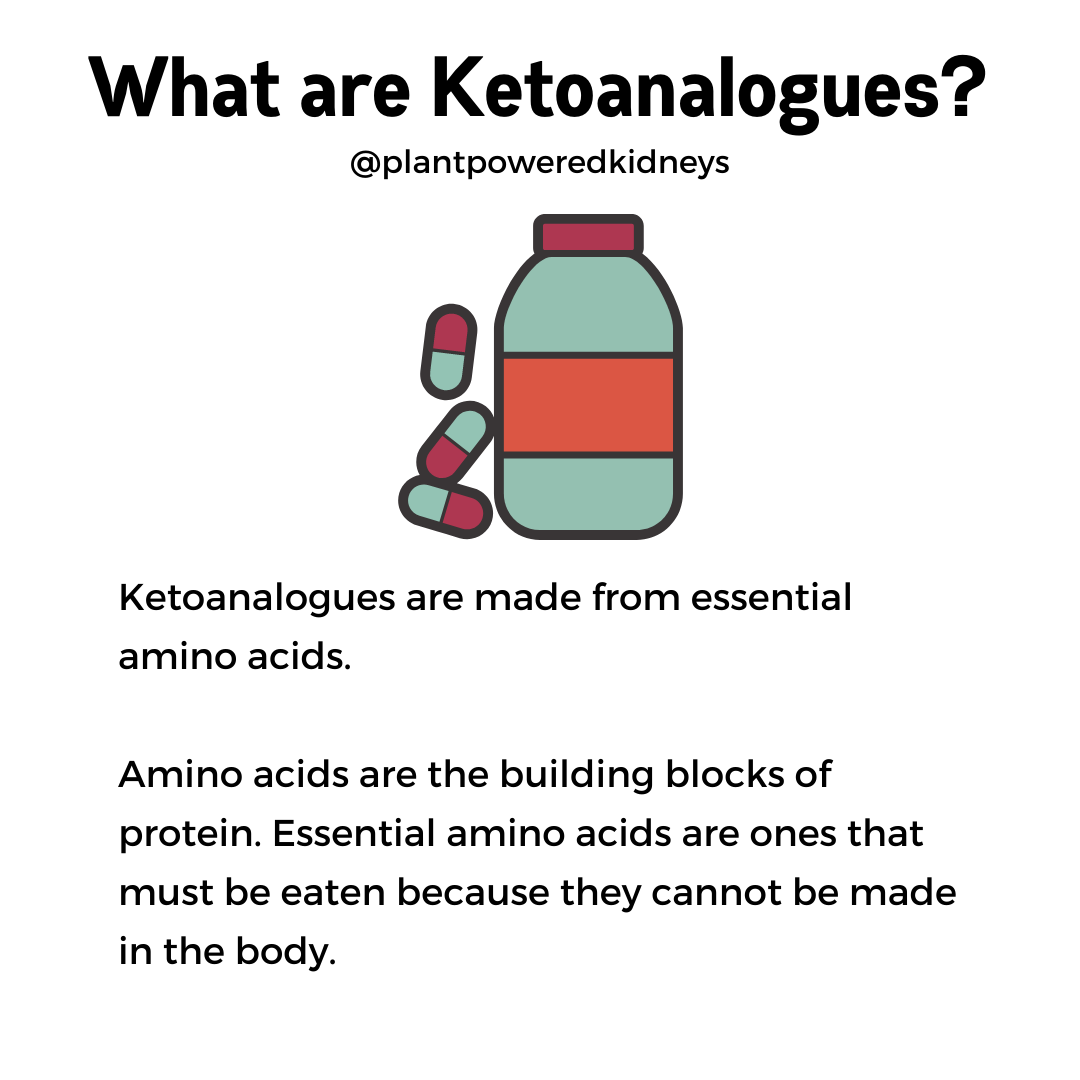
Amino Acids
As mentioned above, amino acids are the building blocks of protein. They play many roles in the body, beyond protein and muscles.
Amino acids also help with synthesizing hormones, neurotransmitters, enzymes, transporters, tissue and cells.
Essential Amino Acids
There are nine essential amino acids.
The nine essential amino acids are:
- Histidine
- Isoleucine
- Leucine
- Lysine
- Methionine
- Phenylalanine
- Threonine
- Tryptophan
- Valine
The reason they are named “essential” is because they cannot be made in the body.
Therefore, we are required to get them through our diet.
Non-essential Amino Acids
Non-essential amino acids are just that, non-essential.
There are eleven non-essential amino acids. They are:
- Alanine
- Arginine
- Asparagine
- Aspartate
- Cysteine
- Glutamate
- Glutamine
- Glycine
- Proline
- Serine
- Tyrosine
Our body is able to make these based on other amino acids and components in the body.
These amino acids are made from glucose, with the exception of tyrosine.
Tyrosine is made from phenylalanine.
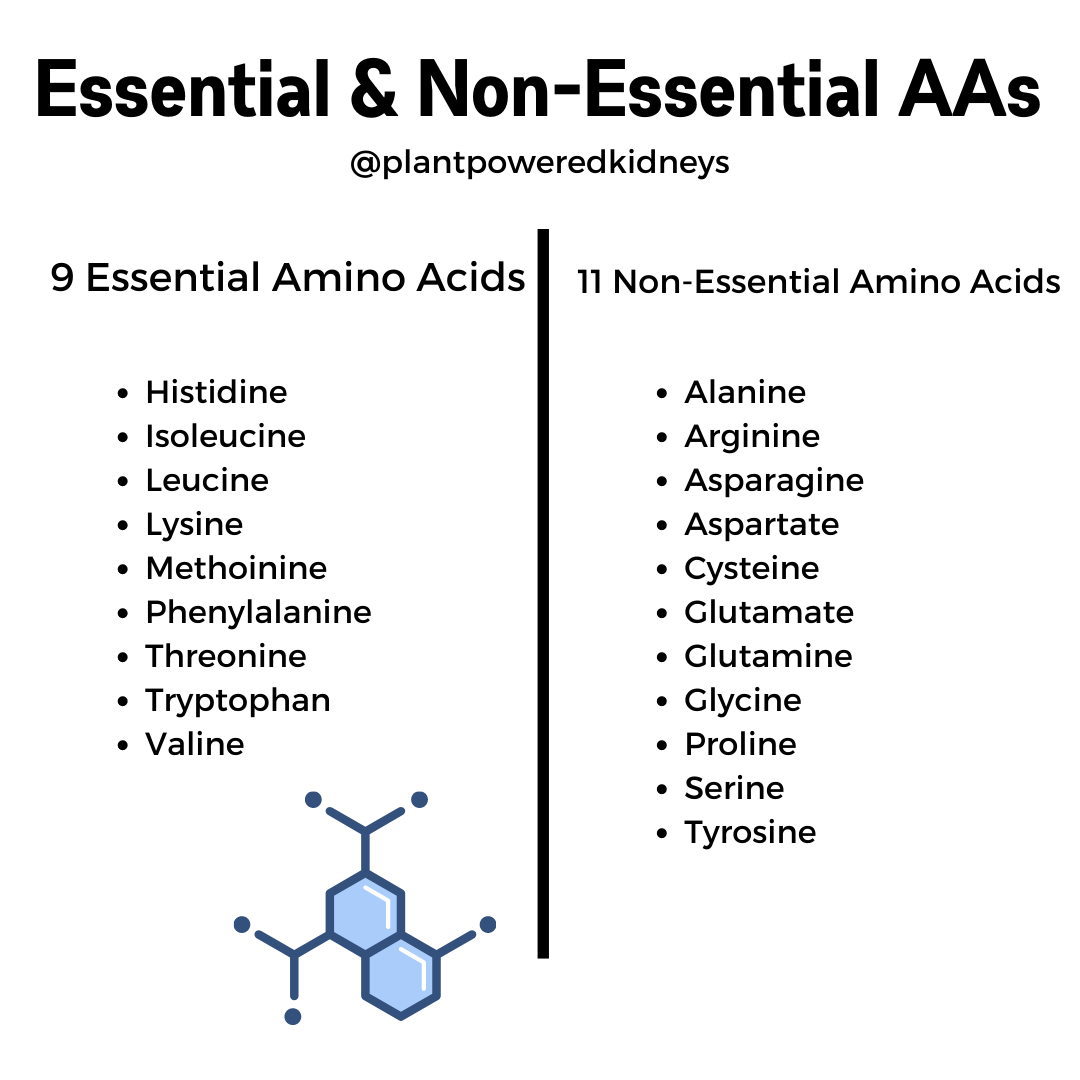
How are ketoanalogues different from amino acids?
As mentioned above, ketoanalogues are a portion of amino acids.
The amino acid supplements typically found over the counter in supplement and health food stores will be the complete amino acid.
This means they still include the components that are harder for the body to break down.
The Low and Very-Low Protein Diet
Before we dive into more about ketoanalogues, it’s important to first understand the low protein diet.
The National Kidney Foundation’s Kidney Disease Outcomes Quality Initiative (KDOQI) published nutrition updates in 2020 to include evidenced-based practices of the renal diet.
The low protein diet is anywhere from 0.55 – 0.8 grams of protein per kilogram of body weight.
The very-low protein diet is a diet with 0.28 – 0.43 grams of protein per kilogram of body weight along with ketoanalogues to meet protein requirements.
Including the ketoanalogues, protein intake should reach 0.55 – 0.6 grams protein per kilogram body weight.
In other words, the ketoanalogues help prevent protein wasting, malnutrition, and deficiencies for someone on a very-low or low protein diet.
Learn more about the low protein diet here.
Who should be on a low protein diet?
According to KDOQI, those in stages 3-5 without diabetes and metabolically stable may benefit in kidney protection with a low protein diet.
Those in stages 3 – 5 and also have diabetes will have a modified low protein diet of approximately 0.6 – 0.8 g/kg/day.
Be sure to speak with your physician to get a referral to a dietitian.
If you can’t get a referral, you can check out the Kidney Foundation’s Dietitian Directory.
Our page here includes additional dietitian resources and other countries’ dietetic associations.
Finally, your health insurance provider may be able to connect you with a dietitian that accepts your insurance. Read our guide, including what to ask, here.
What does metabolically stable mean?
Metabolically stable means there is no active inflammatory or infectious disease present, no recent hospitalization, and no diseases like cancer.
If you have diabetes, this means blood sugars need to be well-controlled.
When should you take ketoanalogues?
Now that you know about ketoanalogues, it’s important to determine exactly who may benefit from them.
Just because you have kidney disease does not mean you should be taking ketoanalogues.
Stage 3 CKD
According to KDOQI, those at CKD3 that are metabolically stable may benefit from a low protein diet, “with or without ketoanalogues.”
However, ketoanalogues are not seen as a first line of defense at stage 3 kidney disease.
The interventions recommended prior to this supplementation may include:
- Low protein diet
- Low sodium diet
- Blood sugar control and management
That being said, ketoanalogues may have a place in supporting those with stage 3 kidney disease if a significant drop in kidney function has been identified.
Read more about stage 3 and helpful interventions here.
Stages 4 and 5 CKD
Stage 4 CKD is for GFR between 15-29. Stage 5 kidney disease is when the GFR is under 15. This is also the stage at which a person can qualify for dialysis and transplant.
Many, however, cannot or choose not to start dialysis and make dietary changes instead. At this point, a low protein or very low protein diet can be an essential part of the dietary interventions.
Research has shown that stage 4 CKD patients can safely benefit from adding ketoanalogues to a low protein diet to prevent the start of dialysis.
The importance in these late stages of CKD is to limit the protein in the diet, no matter the source.
Even a vegetarian diet that is low protein can still benefit with ketoanalogues.
Read more about stage 4 renal diet here and stage 5 renal diet here.
Dialysis with Residual Renal Function
In some cases, those that start dialysis and have a small percentage of kidney function remaining may be advised to use ketoanalogues.
It’s extremely important to discuss ketoanalogues with your dialysis team first as ketoanalogues depend on the residual function of your kidneys.
Ketoanalogues are not used to stop dialysis treatment.
Dialysis is a life-saving treatment for end stage kidney disease. Never stop dialysis treatment before first discussing with your nephrologist and healthcare team.
When Should You Not Take Ketoanalogues?
If you have healthy functioning kidneys, there is no need to take ketoanalogues. They are to support those with lowered kidney function.
If you have high calcium or magnesium levels in your blood test results prior to starting ketoanalogues, you need to first consult with your physician and dietitian.
Potential Benefits of Ketoanalogues
Ketoanalogues have been studied for many years to determine the benefits of including this supplement for those with kidney disease.
Some potential benefits include:
- Slow GFR decline
- Decrease serum creatinine and BUN levels
- Lower oxidative stress
- Decrease metabolic acidosis
- Better phosphorus and parathyroid hormone level management
- Decrease insulin resistance
- Improved blood pressure
- Reduced proteinuria
- Protect lean muscle mass
- Delayed start of dialysis
An observational study in 2018 found that a group following the low protein diet with ketoanalogue supplementation had a lower risk of all-cause mortality, cardiovascular and cerebrovascular events, and infection-related death.
A study published in 2021 found that ketoanalogue supplements reduced mortality in CKD patients not on dialysis with diabetic kidney disease.
However, it’s important to note that ketoanalogues are recommended for those with well-controlled diabetes.
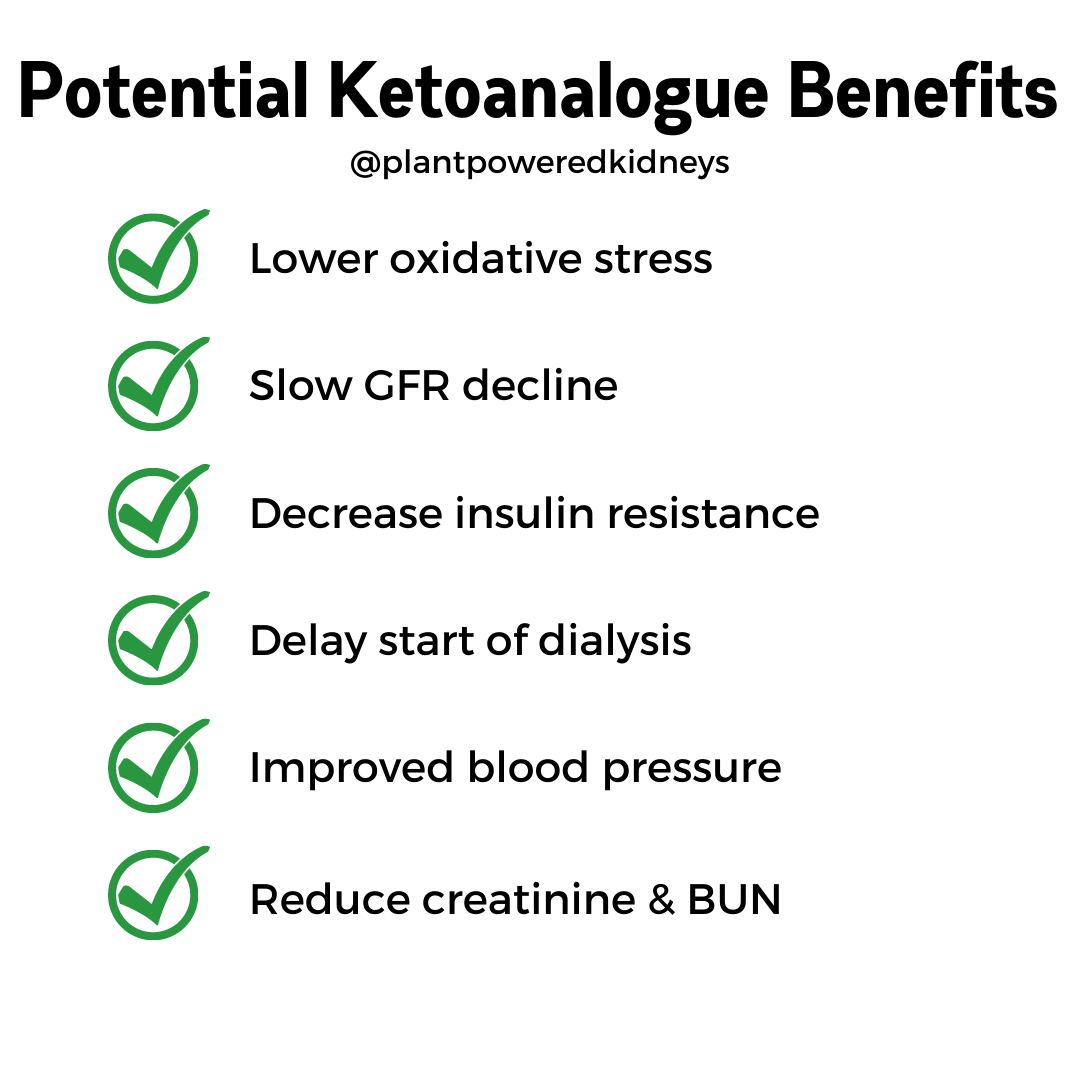
It’s important to know that most of these results are based off of studies of those with stages 4 and 5 kidney disease.
Where Ketoanalogues Have Not Been Proven to Help
While ketoanalogues have shown some great benefits, there are areas that did not show benefits.
Some areas that did not show improvement with ketoanalogues include:
- Cholesterol levels
- Albumin levels
- Anemia & hemoglobin
For these reasons, it’s important to understand that ketoanalogues can help many things, but it’s not a magic “cure-all” for kidney disease.
How Much Ketoanalogues Should I Take?
Ketoanalogues will generally have a standard dosing recommendation included on the packaging.
However, the amount of ketoanalogues to take will depend on your protein intake.
This is why it’s important to work with a renal dietitian to:
- Review your typical dietary protein intake
- Discuss your goal protein intake related to your kidney function, age, activity, and other medical conditions that may impact protein needs
- Calculate the amount of ketoanalogues to take per day or per meal
However, keep this above section in mind. The ketoanalogue dosing for you may be different.
Ketoanalogues Currently Available
Next, we will review the types of ketoanalogues that are currently available.
The manufacturer dosing will be listed for each of the ketoanalogues mentioned. We will also include pricing and other specific features of the ketoanalogues.
Ketorena
Ketorena is a calcium-based ketoanalogue. It is sold in both powder and tablet form.
It was developed by a board-certified nephrologist in the United States
Ketorena includes all of the essential amino acids in ketoanalogue form:
- L-lysine acetate
- Alpha-ketoleucine calcium
- Alpha-ketovaline calcium
- Alpha-ketoisoleucine calcium
- L-Threonine
- L-Histidine
- L-Tyrosine
- L-Tryptophan
Other ingredients include maltodextrin, L-Ornithine HLC, Silica and Sucralose.
Dosing
According to the Ketorena website, the typical powder dose is 1 scoop three times daily with food. Mix the powder into 3 to 4 ounces of water.
For the tablets, typical dose is 3 tablets three times a day with meals.
Each serving provides approximately 5.1 grams protein.
This means a days’ worth of Ketorena KAs will add 15.3 grams of protein.
Cost
At the time of this article’s publication, Ketorena costs $159.50 per 90-serving canister. A 90-serving canister is enough for a one-month supply.
However, purchase at least 2 canisters to get a discount.
Purchasing a three-month supply of 3 canisters totals to $426, before shipping and taxes.
Unique Features of Ketorena
Ketorena has a low calcium content and no magnesium.
This can be helpful as people with chronic kidney disease can be at risk for both elevated calcium and magnesium levels.
It comes in a vanilla-flavored powder or tablet.
According to the website, one scoop of the powder is equivalent to 3 to 4 Ketorena tablets.
Where to order Ketorena
Ketorena does not require a doctor’s prescription. You can order directly through their website.
Do not purchase Ketorena through a third-party supplier. Doing this may put the quality in question.
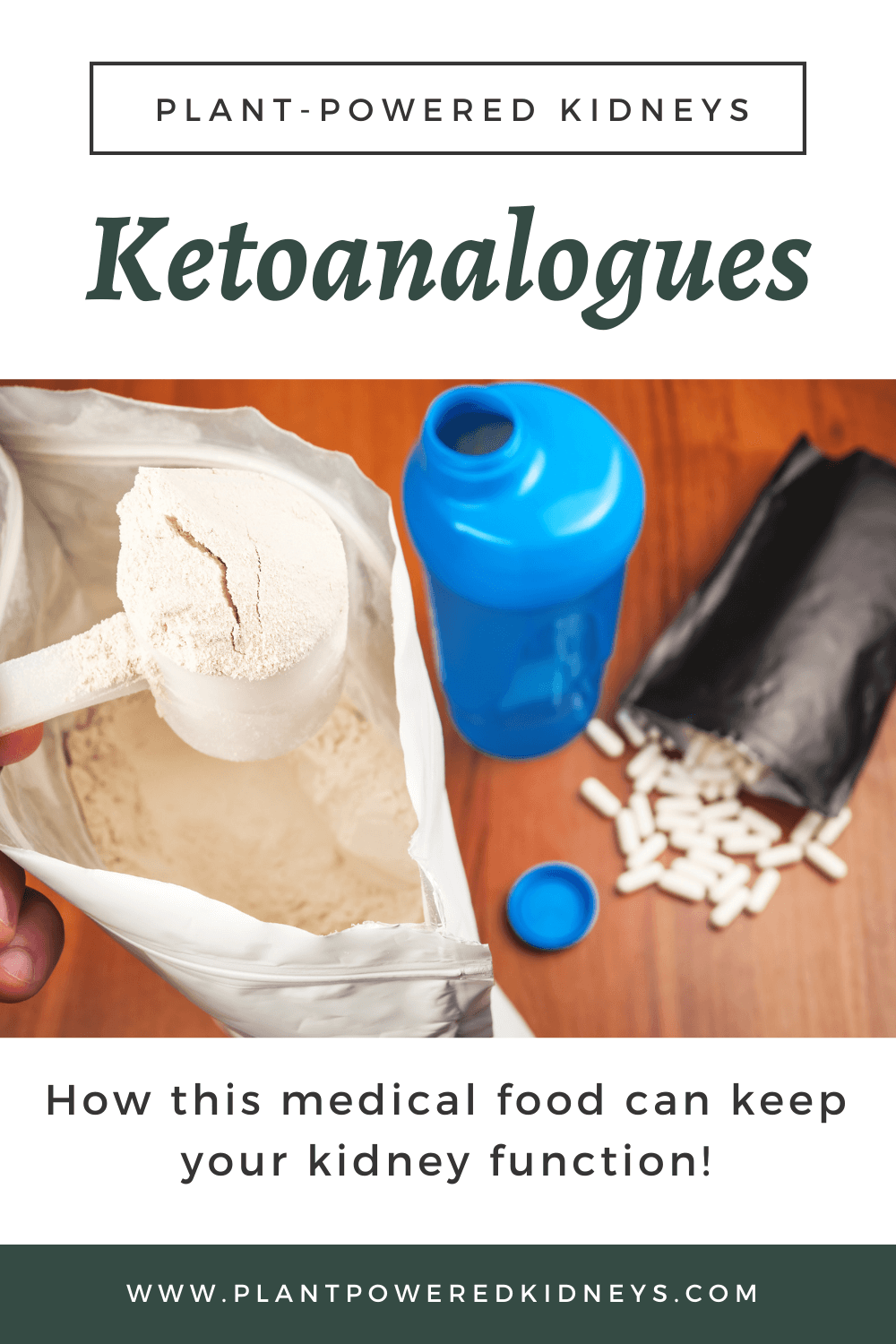
Albutrix
Albutrix is a magnesium-based ketoanalogue product that comes in tablet form.
There are three different ketoanalogues available.
Each ketoanalogue is for the different stages of CKD that may benefit from ketoanalogues with a low or very-low protein diet.
Lee Hull, a patient with FSGS, developed Albutrix. The name may sound familiar as he has written a popular book, Stopping Kidney Disease.
According to the website, the Albutrix-S5 (stated for stage 5 CKD) includes the following ketoanalogues:
- Leucine
- Isoleucine
- Valine
- Methionine
- Phenyalanine
- L-lysine monoacetate
- L-Threonine
- L-Histidine
- L-Tyrosine
- L-Tryptophan
Other ingredients include: maltodextrin, Kollidon CL, microcrystalline cellulose, colloidal silicon dioxide, salc, starch, magnesium stearate, hypromellose, and polyethylene glycol.
Albutrix-S4 and Albutrix-S5 also include nutrition information for calcium, magnesium, and nitrogen.
The nutrition information differs since there are different ketoanalogues for different stages of CKD.
Dosing
According to the package, dosing generally starts at 2 tablets three times a day.
Product details include 1 pill as containing 4-5 grams of protein.
Six pills provides 30 grams of dietary protein.
Cost
At the time of this article publication, one bottle with 180 tablets (approximately a one-month supply based on general dosing) is $199.
This also comes with a 30-tablet (one month) vitamin supplement.
There is no option to purchase the ketoanalogues without the vitamin supplement.
They offer a monthly subscription discount. The discounted subscription price is $179.10 per month.
A three month supply on subscription service totals to $537.30, before shipping and taxes.
Unique Features of Albutrix
Albutrix sells three different types of ketoanalogues:
- Albutrix-S3
- Albutrix-S4
- Albutrix-S5
According to the website, they correlate with different stages of kidney disease.
However, there is no research on the efficacy of different types of ketoanalogues across the different stages.
According to the Albutrix website, it is recommended to choose the different ketoanalogue based on magnesium levels of your most recent blood test.
There is a higher risk of high magnesium levels in stage 4 and stage 5 CKD patients.
On the other hand, CKD patients are also at risk for low magnesium levels due to commonly prescribed medications, dialysis, low albumin levels, and diabetes.
The Albutrix-S3 contains 360 milligrams magnesium for six tablets.
For reference, below are the the Recommended Dietary Allowance (RDA) for healthy adults.
| Age | Male | Female |
|---|---|---|
| 19 – 30 years | 400 mg | 310 mg |
| 31+ years | 420 mg | 320 mg |
Albutrix-S4 contains 180 milligrams of magnesium for six tablets.
Finally, Albutrix-S5 contains no magnesium but instead calcium. In it, there are 459 milligrams of calcium per daily serving.
Where to order Albutrix
There is no doctor’s prescription required to order the Albutrix ketoanalogues.
Go directly to the Albutrix website to order straight from the manufacturer.
As mentioned, an automated monthly subscription will give a discount of about 10%.
Ketosteril
Ketosteril is another calcium-based ketoanalogue.
It was created by Fresenius, a well-known renal & dialysis company.
It includes the following ingredients:
- Calcium-3-methyl-2-oxovaleric acid
- Calcium-methy-2-oxovaleric acid
- Calcium-2-oxo-3-phenylpropionic acid
- Calcium-3-methyl-2-oxobutyric acid
- calcium-DL-2-hydroxy-4-(methylthio)-butyric acid
- L-lysine acetate
- L-threonine
- L-tryptophan
- L-histidine
- L-tyrosine
Other ingredients include corn starch, crospovidone, povideone, talc, highly dispersed silicon dioxide, magnesium stearate, macrocol 6000, colouring agents E104, E171 alkaline polymethacrylate, glycerol triacetate.
The total nitrogen content per tablet is about 36 milligrams. Total calcium content is 0.05 grams.
Dosing
Ketosteril directions are for 4-8 tablets three times a day during meal.
Cost
At the time of this article publication, cost varied slightly between some of the online drug stores that sold Ketosteril. However, the general cost of one box with 100 tablets was approximately $90.
For a full month’s supply with the starting dose, it would come out to $360 per month.
Unique Features of Ketosteril
Ketosteril, being backed by a large pharmaceutical company, has also been used for the most research related to ketoanalogues.
Where to Order Ketosteril
This ketoanalogue is available by prescription only.
There are several online pharmacies that offer Ketosteril. However, it would be best to first speak with your nephrologist to see if they would be able to order it.
There are potential risks for scams when ordering in unfamiliar sites that are not the direct manufacturer, including ordering on Amazon.
Labs to Track When Using Ketoanalogues
Since ketoanalogues are a part of preventing kidney disease progression, it’s important to continue to monitor labs.
This is another reason why it is important to first discuss with your physician.
Some of the labs that you should discuss monitoring with your physician include:
- Complete blood count (CBC)
- Renal function panel
- Magnesium
- Prealbumin
- Urine analysis
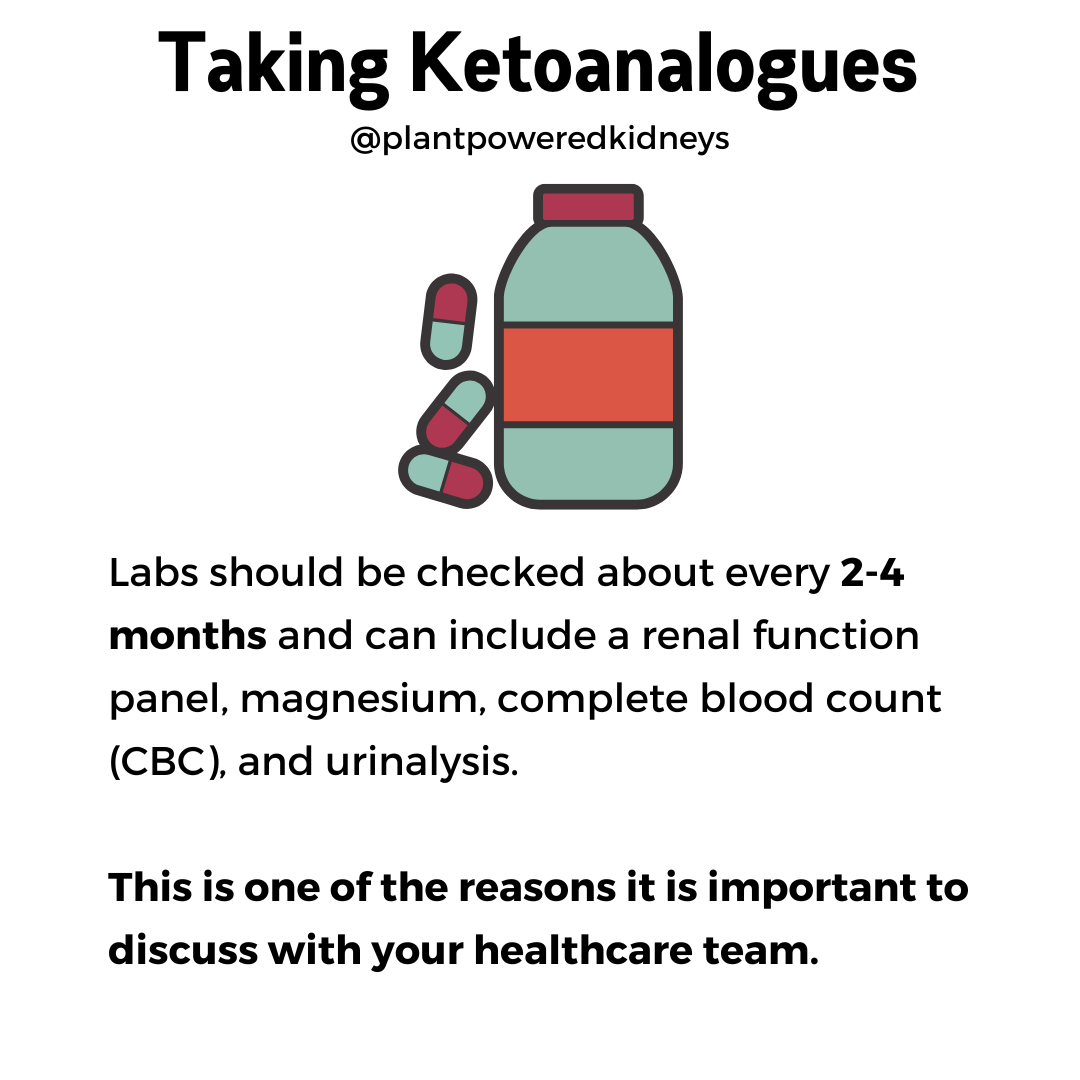
According to Ketorena, these labs should be checked every 2 to 4 months.
So, other labs to be evaluated every 4-6 months or yearly include:
- Albumin-to-creatinine ratio
- Protein-to-creatinine ratio
- Iron
- Intact PTH
- Vitamin D
- Hemoglobin A1c for those with diabetes
- Lipid panel for those with high triglycerides, cholesterol, or other lipid abnormalities
Other Questions about Ketoanalogues
Below are some questions we have received when it comes to adding ketoanalogues into your renal diet routine.
Can I take ketoanalogues without a dietitian?
While it is possible to take ketoanalogues without a dietitian overseeing your care, it’s not recommended.
Dietary interventions alone, including a low protein diet, have been shown to be ineffective without proper nutrition support.
Does health insurance cover ketoanalogues?
Unfortunately, health insurance does not cover the cost of ketoanalogues. Because of this reason, cost is often the biggest barrier when it comes to using KAs.
You may be able to use a health savings account to purchase ketoanalogues as they are a medical food. Check with your HSA provider before purchasing.
Another option is to keep receipts for a tax-deductible medical expense.
How are ketoanalogues different from branched-chain amino acids?
Branched-chain amino acids (or BCAAs) are three of the essential amino acids: leucine, isoleucine, and valine. Their chemical structure is what makes them branched-chain amino acids.
Ketoanalogues include the branched chain amino acids. However, BCAAs do not include the other essential amino acids that ketoanalogues do.
A study in the Journal of Renal Nutrition in 2020 looked at the use of BCAA-enriched dialysis fluid to see if it would support amino acid levels.
They did find that the supplemented fluid used in the dialysis treatment helped with plasma concentrations. Of course, more research is needed to verify long-term benefits and outcomes.
What about liquid aminos?
Liquid aminos are basically amino acids that are from soybeans. As an amino acid and not a ketoanalogue, they will still have the nitrogen piece.
Therefore, liquid aminos like Coconut Secret or Bragg’s are not equivalent to ketoanalogues.
An important consideration when using liquid aminos is the sodium content. This can range from 90mg to several hundred milligrams of sodium per serving.
Be sure to read the label so you know how much sodium is in your liquid aminos.
Are ketoanalogues related to the keto diet?
It may sound confusing, but ketoanalogues have nothing to do with the high-fat, low-carb diet known as the keto diet.
Learn more about the keto diet and kidney disease here.
Are there side effects with ketoanalogues?
Potential side effects of ketoanalogues can be high levels of calcium or magnesium.
This is why it’s important to speak first with your doctor about ketoanalogues so you can develop the right tracking process.
There are no common side effects otherwise noted.
For how long does someone need to take ketoanalogues?
The length of time ketoanalogues are needed in the diet will depend on many factors.
Changes in kidney function, lab test results, and other health conditions may change the dosing or even result in completely stopping KA supplements.
The recommended minimum length of time to use ketoanalogues is generally three months, unless otherwise indicated by your physician or dietitian.
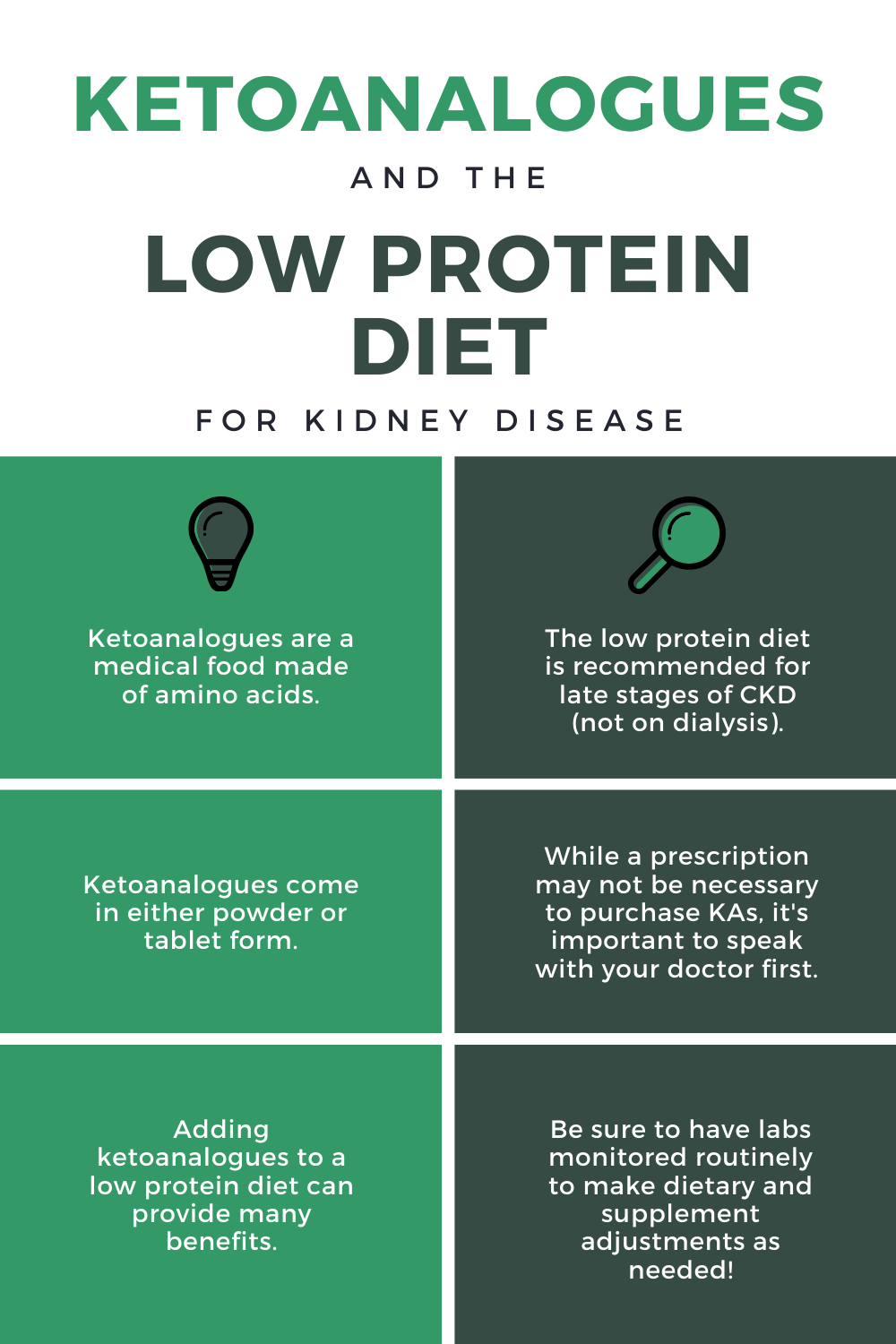
The Bottom Line
Ketoanalogues can be an important part of a renal diet that is aimed at stopping progression of chronic kidney disease.
However, there is risk of aggravation and further kidney disease progression if taken without proper medical supervision.
It’s important to discuss any and all supplements prior to starting with your healthcare provider to ensure it’s the right thing for you.
And with ketoanalogues, it is especially important to work with a renal dietitian to ensure that you’re getting the right amount of protein from both ketoanalogues and your diet.
Prior to starting ketoanalogues, it’s important to understand the low protein diet. Click here to read more about the low protein diet.


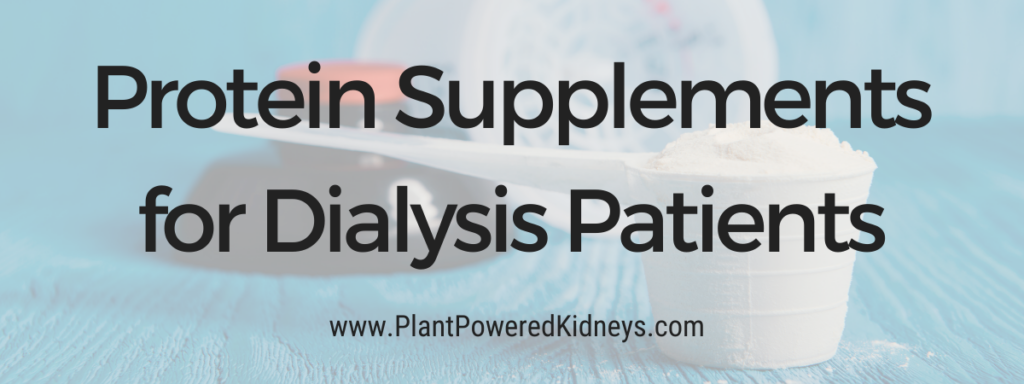
This is such a helpful article! It answered all of my questions regarding ketoanalogues in one place. I have it saved in my notes to refer back to and to share with friends and family as I continue on my kidney health journey. Thank you!
We’re so happy to hear that, Christie! Thank you for the kind words 🙂
Excellent and concise information.
Thank you for easy and useful path to controlling ckd.
Thank you, Mavi! 😊
what if you are already on PD dialysis? Does this only work if you can be on a low protein diet?
Ketoanalogues are typically recommended for mid- and late-stage CKD, not on dialysis. It’s quite an expensive supplement that has not shown enough proof to justify KAs for dialysis patients. More research is needed before we would recommend it otherwise.
how long do I take a ketoanaloques, taking for lifetime good? I am now 79 years so I would like to take .
It depends. Ketoanalogues should be monitored by your healthcare team. The dose and duration may need to be adjusted. It’s also dependent on your kidney function, protein intake in your diet, and other personal factors.
So, Medicare Plan G or N will also not cover the cost of prescription Ketoanalogues? That applies to Plan D prescription plans also?
Ketoanalogues are not currently covered by health insurance (to my knowledge). If you find something that shows otherwise, please feel free to share it with us. 😊
Thank you for the article. Can Ketoanalogues cause lack of energy? thanks
Hi Sen! Ketoanalogues do not generally cause low energy levels. If anything, people may experience better energy levels as they are getting more of the amino acids their body needs. But some do not experience a change in energy even with ketoanalogues. It may be connected to anemia and iron stores.